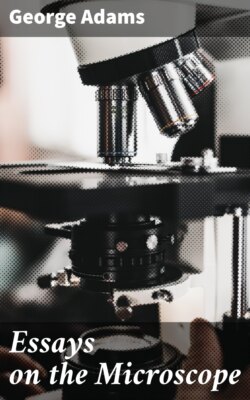Читать книгу Essays on the Microscope - George Comp Adams - Страница 58
На сайте Литреса книга снята с продажи.
DESCRIPTION OF A PORTABLE MICROSCOPE AND TELESCOPE. Plate VIII. Fig. 1, to 6.
ОглавлениеTable of Contents
The telescope is one of those which are composed of several sliding drawers or tubes, for the convenience of being put into the pocket; the sliding tubes are made of thin brass, the outside tube of mahogany. The sliding tubes are contrived to stop, when drawn out to a proper length, so that by applying one hand to the outside tube, and the other hand to the end of the smallest tube, the telescope may at one pull be drawn out to its full length; then any of the tubes (that next the eye is most generally used) may be pushed in gradually, while you are looking through it, till the object is rendered distinct to the eye. To make the tubes slide properly, they all pass through short springs or tubes; these springs may be unscrewed from the ends of the sliding tubes, by means of the milled edges which project above the tubes, and the tubes taken from each other if required, and the springs set closer if at any time they be too weak.
Fig. 5 represents the exterior tube of the telescope, which is to be unscrewed from the rest, at m l, as it does not make any part of the microscope; the cover, k, which protects the object-glass, serves also as a box to contain two ivory wheels, Fig. 1 and 2, with the objects, and a small mirror, Fig. 6.
Fig. 4 is a view of this cover when taken off: unscrew the top part of it, and the mirror, Fig. 6, may be taken out; unscrew the cover of the lower part, and you will find therein the two circular object-wheels above mentioned.
Fig. 3 represents the three internal tubes of the telescope, which constitute the microscopic part thereof. Draw the tubes out in the manner as shewn in the figure; then at the inside, but at the lower end of the exterior tube, a, you will find a short tube, which serves as a stage to hold the object and support the mirror; pull this tube partly out, and turn it, so that a circular hole which is pierced in it may coincide with a similar hole in the exterior tube. This tube is represented as drawn out at Fig. 3, the mirror, Fig. 6, placed therein at b c, and the transparent object-wheel fixed at a.
Fig. 1 represents the slider with transparent objects.
Fig. 2, that with the opake. They are made of ivory, and turn on a pin at the center; the slit end of this pin fits on the edge of the tube, which is then to be pushed up, so that the lower end of the exterior tube may bear lightly on the upper side of the slider, agreeable to the view which is given at a, Fig. 3. Now push down the second tube till the milled part falls on the milled edge of the extreme tube, being careful of the circular hole in the exterior one. Nothing now remains to be done but to adjust for the focus, which is effected by pushing in the tube R, and moving only the first, n.
The instrument may be used in two ways for transparent objects: first, in a vertical position, when the light is to be thrown on the object by the mirror, b c; or it may be examined by looking up directly at the light; in the latter case the mirror must be taken away. In viewing opake objects the mirror is not used; as much light as possible must be admitted on them through the circular holes of the tubes. Any object may be viewed by first pushing in the tube, R, and then bringing the tube, n, to its focal distance from the object. The telescope, when shut up, is about eight inches in length, and when drawn out, is about twenty inches. It is of the achromatic construction.
